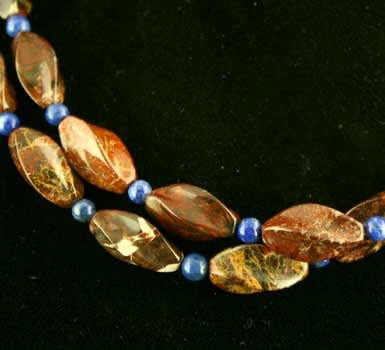Jasper and Lapis Lazuli Bead Necklace
Jasper and Lapis
FJ.7261
Jasper is an opaque member of the quartz family, found in a variety of colors but most commonly green, red, yellow, brown or mottled (called leopard's skin). Because of its...
Jasper is an opaque member of the quartz family, found in a variety of colors but most commonly green, red, yellow, brown or mottled (called leopard's skin). Because of its rich hues and the fact that it polishes to a high luster, jasper has been used in jewelry throughout history. Moreover, the protective properties of the stone, which vary depending on the color, have favored its use in amulets and talismans since before recorded history. In the Old Testament (Exodus, xxviii 15-30) jasper is named as one of the twelve stones representing the twelve tribes to be set in gold and placed in the breastplate of the High Priest. The Egyptians carved scarabs from jasper; the Greeks and Romans made entire vessels from it, believing that the stone's powers would pass to them through the food or drink the vessel's contained. Jasper's chief virtues since antiquity has lain in its ability to attract poisons and venoms into itself, thus removing the cause of disease. This is especially believed to be true of green jasper, which was used in the ancient and medieval worlds to cure snakebite. The verdant green stone has also been associated for millennia with rainfall, fertility and abundance. Red jasper is said to cure ailments of the blood, and to imbue the wearer with renewed strength and vigor. Its associations with the deities of combat and courage are thought to make red jasper an ideal stone for those seeking victory over existing disease. Yellow and brown jaspers are useful for maintaining a healthy liver and spleen. Jasper is found throughout the world, and mankind is fortunate that in addition to its helpful nature, it is also extremely becoming to wear.
Beautiful as the moonlit sky shot through with golden stars, lapis lazuli has been treasured since the dawn of civilization. Its sources are few, mostly in eastern mines of what is now Afghanistan, and its rarity made it the favored jewel of ancient royalty. The kings and queens of Mesopotamia had their cylinder seals carved of lapis; the Egyptians made their most precious amulets from it. So eager were the Egyptians for objects made from lapis that they created an imitation paste from the ground stone. During the Renaissance, the rich ultramarine of the great master paintings was also made from powdered lapis, brought overland on arduous journeys that took years. Poets from ancient Sumer through the modern age have used it as metaphor of beauty and rarity. Besides its appealing loveliness, the gem is thought to have curative powers and is used as a remedy for fever, gall-stones, sleeplessness and above all, melancholy. Who, looking upon this splendid stone could feel anything but happiness?
Beautiful as the moonlit sky shot through with golden stars, lapis lazuli has been treasured since the dawn of civilization. Its sources are few, mostly in eastern mines of what is now Afghanistan, and its rarity made it the favored jewel of ancient royalty. The kings and queens of Mesopotamia had their cylinder seals carved of lapis; the Egyptians made their most precious amulets from it. So eager were the Egyptians for objects made from lapis that they created an imitation paste from the ground stone. During the Renaissance, the rich ultramarine of the great master paintings was also made from powdered lapis, brought overland on arduous journeys that took years. Poets from ancient Sumer through the modern age have used it as metaphor of beauty and rarity. Besides its appealing loveliness, the gem is thought to have curative powers and is used as a remedy for fever, gall-stones, sleeplessness and above all, melancholy. Who, looking upon this splendid stone could feel anything but happiness?
